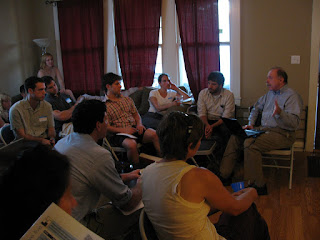
An Evening with the New Orleans Master Plan
By: Gill Benedek
Soon to be Published in The NPN Trumpet
On June 18th, a group of young-professionals gathered at the Moishe House to review the New Orleans Master Plan. The Moishe House invited planners David Dixon and Raphael Rabalais from Goody-Clancy & Associates to join the Master Plan review session. Earlier this year, New Orleans’ a voted on a Charter Amendment that would give the Master Plan the "force-of-law" - thus making it a legally binding document that greatly influences zoning and policy decisions for the next twenty years. A Master Plan is a document that describes, through narrative, maps and other data an overall development vision for a city's future development. The master plan is used to coordinate the preparation of more detailed plans or may be a collection of detailed plans. The plan may be prepared by a local government to guide private and public development or by a developer on a specific project.

Currently weighing in at over 500 pages, the Master Plan is packed with data, historical analysis, land use maps and sweeping policy suggestions. The evening’s purpose was to offer an opportunity for an in-depth review of the current Master Plan draft. Out of the approximately 40 people in attendance, only a handful of the evening’s participants were raised in New Orleans. While this bolstered Goody Clancy’s hope and belief that the 23-35 age demographic will migrate to New Orleans, it also highlighted the existing divisions among New Orleans' Generation Y demographics.
After a 40 minutes overview of the Masterplan, the participants broke out into 3 groups to discuss their areas of greatest interest: land use, economic development and housing. Every table engaged in a lively discussion of the issues and were tasked with identifying the Master Plan policies they supported, challenging the Master Plan’s assumptions and suggesting new strategies.
 As one participant that evening noted, “The master plan meeting was an incredible opportunity to meet directly with David Dixon and Raphael Rabalais who have worked on the master plan as well as other planning efforts in New Orleans.”
As one participant that evening noted, “The master plan meeting was an incredible opportunity to meet directly with David Dixon and Raphael Rabalais who have worked on the master plan as well as other planning efforts in New Orleans.”The following is a summary of points concluded by the breakout groups:
Land Use: The land use maps, ultimately one of the most important elements due to its influence on zoning, did not reflect the forward-thinking, bold revitalization suggestions discussed in other chapters. By suggesting more of the same, the land us maps only re-enforce a "status quo"for development rather than leading the coordinated, innovative and sustainable urban growth that the Master Plan recommends.

Housing: Being such a large issue, this group spent a good deal of time asking David Dixon further questions about housing policy in New Orleans. Common points that were echoed by the participants included strategic suggestions such as:
- New city agency positions to interact as liaisons to neighborhoods.
- Increase funding to important housing departments like NORA.
- Raising city salaries to attract talented people to work in city hall.



No comments:
Post a Comment